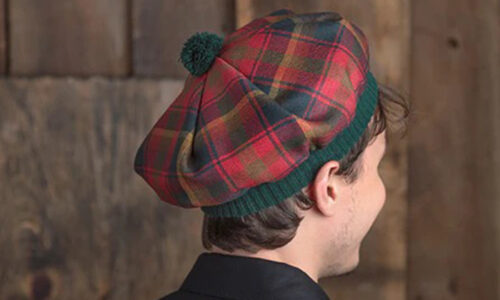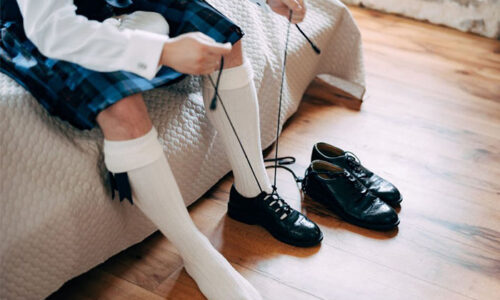Kilts are a traditional Scottish garment that have been worn for centuries. They are made of high-quality wool or other fabrics, and as such, they require special care and attention when it comes to cleaning. In this article, we will cover how to clean a kilt properly, including hand washing, machine washing, drying, pressing, stain removal, and storage. By following these simple tips, you can keep your kilt looking fresh and new for years to come.
Preparing to Clean a Kilt
Before you begin cleaning your kilt, it is important to prepare properly. This includes checking the care label and gathering the necessary supplies.
Checking the Care Label
The care label on your kilt will provide important information about the fabric and any special care instructions. If your kilt is made of wool, it may require hand washing or dry cleaning only. Other fabrics may be machine washable, but require specific settings or detergent.
Gathering Supplies
To clean your kilt, you will need the following supplies:
- Sink or bathtub
- Mild detergent (such as Woolite)
- Drying rack or flat surface
- Iron or steamer (optional)
- Stain remover (optional)
Hand Washing a Kilt
Hand washing is the preferred method for cleaning a kilt, especially if it is made of wool. Follow these steps to hand wash your kilt:
- Fill the sink or bathtub with lukewarm water.
- Add a small amount of mild detergent to the water and mix well.
- Submerge the kilt in the water and gently agitate it for a few minutes.
- Let the kilt soak for 10-15 minutes.
- Gently agitate the kilt again for a few minutes.
- Drain the water and rinse the kilt thoroughly with lukewarm water.
- Squeeze out any excess water, but do not wring or twist the fabric.
- Lay the kilt flat on a drying rack or a clean, flat surface to air dry.
Machine Washing a Kilt
If your kilt is machine washable, follow these steps to ensure it is properly cleaned:
- Use the delicate or wool cycle on your washing machine.
- Use a mild detergent, such as Woolite, and follow the instructions on the label.
- Protect the kilt by placing it in a mesh laundry bag or pillowcase.
- Use cold water for the wash cycle.
- Once the cycle is complete, remove the kilt from the washing machine and gently squeeze out any excess water.
- Lay the kilt flat on a drying rack or a clean, flat surface to air dry.
Drying a Kilt
After washing your kilt, it is important to let it dry completely before storing or wearing it again. Here are two methods for drying your kilt:
- Laying the Kilt Flat: Lay the kilt flat on a clean, dry towel or flat surface. Gently pat the kilt with another towel to absorb any excess water. Flip the kilt over and repeat on the other side. Once the kilt is mostly dry, hang it on a hanger to finish drying.
- Using a Drying Rack: Place the kilt on a drying rack, smoothing out any wrinkles or folds. Turn on a fan or open a window to speed up the drying process.
Pressing a Kilt
To keep your kilt looking its best, it may need to be pressed after washing. Here are two methods for pressing a kilt:
- Ironing a Kilt: Set your iron to the appropriate temperature for the fabric of your kilt. Lay the kilt on an ironing board or flat surface, smoothing out any wrinkles. Use a damp cloth between the iron and the kilt to protect the fabric. Gently press the iron onto the fabric, being careful not to tug or pull on the kilt.
- Steaming a Kilt: If you don’t have an iron, you can also use a steamer to remove wrinkles from your kilt. Hang the kilt on a hanger and use the steamer to remove any wrinkles.
Removing Stains from a Kilt
If your kilt gets stained, it is important to treat the stain as soon as possible. Here are two tips for removing stains from a kilt:
- Treating Stains Quickly: The longer a stain sits on your kilt, the harder it will be to remove. As soon as you notice a stain, blot it with a clean cloth to remove any excess liquid. Then, apply a stain remover or detergent to the stain and let it sit for a few minutes before washing.
- Using the Right Products: Depending on the type of stain, you may need to use a specific product to remove it. For example, blood stains can be removed with hydrogen peroxide, while grease stains can be removed with dish soap.
Storing a Kilt
When you’re not wearing your kilt, it’s important to store it properly to prevent wrinkles and damage. Here are two tips for storing a kilt:
- Folding a Kilt: To fold a kilt, lay it flat on a clean surface. Fold the pleats towards the back of the kilt, then fold the top of the kilt down over the pleats. Fold the bottom of the kilt up to meet the top, then fold the sides inwards. Store the folded kilt in a drawer or on a shelf.
- Hanging a Kilt: To hang a kilt, use a wooden or padded hanger. Hang the kilt by the waistband, being careful not to stretch or pull the fabric. Store the hung kilt in a closet or on a clothing rack.
Conclusion
In conclusion, cleaning a kilt may seem like a daunting task, but with the right tools and techniques, it can be done easily and effectively. By following the tips outlined in this article, you can keep your kilt looking clean and fresh for years to come. It is important to remember to always read the care label and instructions that come with your kilt to ensure that you are cleaning it properly. And, if you are unsure about any part of the cleaning process, don’t hesitate to consult a professional kilt cleaner.
FAQs:
Q: Can I wash my kilt in hot water?
A: It is not recommended to wash a kilt in hot water, as this can cause the fabric to shrink or fade.
Q: Can I dry my kilt in a dryer?
A: It is not recommended to dry a kilt in a dryer, as the heat can damage the fabric and cause shrinkage. It is best to air dry your kilt by laying it flat or hanging it on a drying rack.
Q: Can I use bleach to remove stains from my kilt?
A: It is not recommended to use bleach on a kilt, as it can damage the fabric and cause discoloration. Instead, try using a stain remover or detergent specifically designed for the type of stain.
Q: How often should I clean my kilt?
A: The frequency of cleaning your kilt depends on how often you wear it and how dirty it gets. It is generally recommended to clean your kilt after every few wears, or as needed.
Q: Can I wash my kilt in a washing machine with other clothes?
A: It is best to wash your kilt separately from other clothes to prevent damage to the fabric or pleats. If you must wash it with other clothes, make sure to place it in a mesh laundry bag or pillowcase to protect it during the wash cycle.




